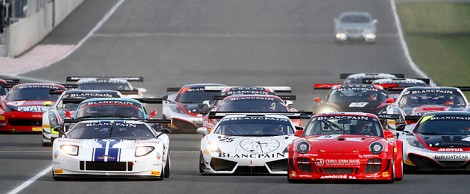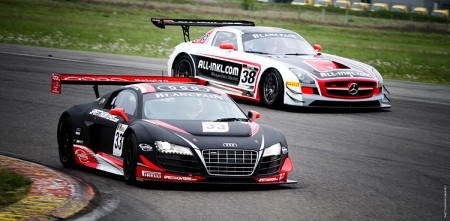Sports car racing’s most influential governing bodies, FIA and ACO, have announced plans to introduce a single, lower-cost set of GT regulations in 2015.
Federation Internationale de l‘Automobile and Auto Club l’Oueste, which control most auto racing around the world and the various Le Mans series, will form a working group in November to devise regulations for a new GT class (racing cars based on street-legal sports cars) which should hit the track three years from now.
GT racing is currently divided into GTE, with very strict regulations, and GT3, a cheaper alternative with more open rules.
GTE is getting expensive. While it flourishes in North America, where manufacturers compete for market share, it languishes in Europe, where the economy is even worse the in the U.S.
GT3 is enormously popular, but the open rules leave too much to interpretation. Manufacturers don’t want to get too involved when success could be decided by race officials rather than racing.
ACO sporting manager Vincent Beaumesnil told Autosport on Oct. 13, “The GT manufacturers support the GTE regulations, but it is clear at the same time that GT3 is a great success. It has been decided together by the FIA to establish a working group with all the manufacturers involved in GT racing to create a single category worldwide.
“We have three main targets: to keep the technical credibility of GTE; to achieve the reduced costs of GT3; and to allow the manufacturers to develop one car rather than the two that they have to today.”
GTE is based on homolgated chassis (purpose-built chassis approved by the organizers) with race-specific suspensions and engines. The rules allow a lot of modifications from the stock cars but are very precise—the idea is that manufacturers can build cars with almost equal performance, loosely based on showroom models.
GTE has gotten continually more expensive as major manufacturers like Porsche, Chevrolet, Doge/SRT, Ferrari, and BMW continue to build more exotic version of their street cars. The factory involvement drives up price to the point where the pool of teams wealthy enough to compete shrinks.
GTE cars are only raced in the prestigious Le- Mans-based series: American Le Mans Series, European Le Mans Series and World Endurance Championship. While these are the unquestioned pinnacle of GT racing, room at the top is limited, and lately entries have dropped in all but the ALMS.
GT3 cars are much closer to street cars, using reinforced stock chassis and modified street motors. GT3 has very few rules except safety regulations—cars are tested twice annually and given intake restrictors and ballast to equalize the performance between the widely diverse makes involved.
While GTE has strict engine limits, GT3 allows almost anything; more powerful cars have to weigh more and use less air to equalize performance. GTE mandates eight cylinders maximum and 5.5 liters displacement (thought the Dodge/SRT Viper was given a waiver for its 8.8-liter V10,) while GT3 allows V10s and V12s of any size.
This allows a far greater range of cars to race in GT3: Lamborghini Gallardos, McLaren MP4-12s, Audi R8s, Mercedes SLSs, BMW Z4s with V8 engines, and Ford GTs are popular—all cars which cannot race in GTE because their manufacturers do not want to spend the money to design GTE-specific models.
GT3 is mostly a customer class—factory involvement was minimal, and more rich hobbyists than professional drivers and teams raced in the class, which became popular all around the world, with national and international championships.
GT3 is also growing more expensive as the class gains popularity; manufacturers are starting to see it as an alternate battleground where they might gain some advantage through the looser rules. However, the series-imposed equalization, called Balance of Performance, creates potential headaches as teams think certain models get too many or too few advantages.
BoP is an issue with GTE as well, as many cars are granted waivers from the rules to allow them to compete with more exotic designs, but at least with GTE factories know they have a strict set of rules to build to, and they can protest a car which deviates too much.
GT3 is more “Run what ya brung” but the decision of the judges is final.
Ideally the new series would allow both the mundane sports coupes from Nissan, BMW, and Acura as well as sports cars like the Corvette, Dodge Viper, and Mercedes SLS, and also supercars like the Ferrari 458 and McLaren MP4-12, with performance equalizers firmly ensconced in the rules, and not open to constant debate.
Fuel-flow metering, which ACO specifies in its 2014 LMP1 prototype rules, would be a good starting point: the engine can be any size but it only gets so much fuel for a given number of laps. Other possibilities would include sliding scales for weight, power, and tire width.
The Epoch Times publishes in 35 countries and in 19 languages. Subscribe to our e-newsletter.












